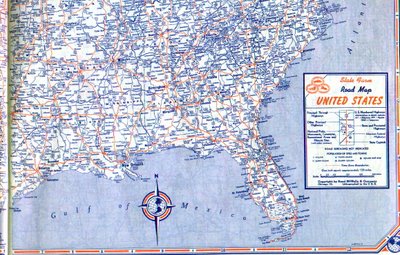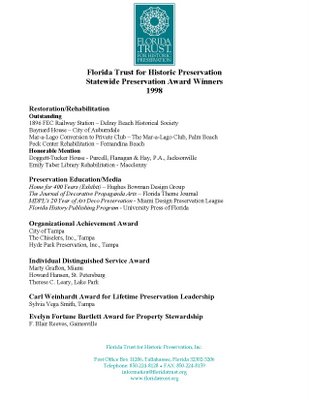You know how you get started at something on the computer and then you find yourself following what began as a tangent - then it becomes an all consuming mission. That's kind of what happened as I started assembling pictures available off the Internet that had a Lake Worth connection. The result is this blog entry. Beyond my interest in Lake Worth and local history, these pictures of familiar areas in a different state, representing a different time, remind us that the only constant is change. Many people have gone before us and they did what they had to do in order to survive and live in the time of history that they occupied. The land remains here, but the names, faces and appearances are like a thin layer on top of the earth that is more transient than we would sometimes like or want to believe.One of my interests happens to be antique/classic/special interest automobiles. I was happy to stumble onto a site that had a postcard of a former Rambler/American Motors dealership on North Dixie Hwy. That led me to look for old road maps and then information on U.S. Highway 1 that was the way to get to south Florida from the northeast - before the advent of I-95. We forget that our forefathers and mothers lived off a very busy Dixie Highway lined with kitchy motels, car dealers, fast food outlets. This artery pumped money into the local economy and much of the City's earlier prosperity directly sprung from this highway. I also found a very early map of railroads in Florida - dating from 1893. This pre-dates the extension of the FEC railroad along the east coast of Florida which become one of Henry Flagler's greatest achievements - after retiring from Standard Oil.So, enjoy! And remember that in most browsers you can click on the image and it will appear large in another window. Some images can be further explored by clicking again, making the image larger.
 The Art Deco Lake Theatre opened in 1939. It was also known as the Lake Avenue Theatre. The theatre was designed by Roy A. Benjamin who also did the Florida Theatre in Jacksonville and many others in FL. In 1980, it was renovated and transformed into the Lannan Museum and Palm Beach Community College Museum of Art. It was then bought and renovated again in 1999 to become PBICA (Palm Beach Institute of Contemporary Art).
The Art Deco Lake Theatre opened in 1939. It was also known as the Lake Avenue Theatre. The theatre was designed by Roy A. Benjamin who also did the Florida Theatre in Jacksonville and many others in FL. In 1980, it was renovated and transformed into the Lannan Museum and Palm Beach Community College Museum of Art. It was then bought and renovated again in 1999 to become PBICA (Palm Beach Institute of Contemporary Art).
As seen when it was the home of the PBICA:

The following is the postcard of the car dealership that was at the northwest corner of N. Dixie Hwy. and 14th Avenue North. Judging by the steel in the parking lot, I'd say the picture is from the early 1960s. 
My parents actually had a light green 1959 Nash Rambler 2 door (see inset) that might have brought me home from the hospital after my entry into this world in 1961. (I just chatted with my Dad and he thinks that car came after I was born. The "delivery" vehicle was probably a '53 Chrysler station wagon) There was a rather deep recession in the late 1950s and American Motors really had the only "economy car" on the market at the time. Its sucess spawned the General Motors Corvair line, the Falcon for Ford and the Dart for the Chrysler Corporation - under the Dodge brand.
Anyway, this picture is looking north from what is now the Save-a-Lot parking lot - probably someone standing on a ladder. For kicks and giggles, I ran out today and took a current picture of the property. It looks like many of the original buildings are there still, but used for a slightly different purpose. The "showroom" was under a roof, but open on all sides, with offices to the rear. This was a common layout of car showrooms during this era in Florida. Remember Clark Oldsmobile in downtown West Palm Beach? Similar concept. That property is now the site of one of the mega-residential buildings now under construction in West Palm.

Notice the lights strung over the cars, the flags, the big sign - all to draw the attention of the passing motorist. And all are strictly outlawed through our current zoning code. I don't think there is one living plant on property as seen in the old picture. You can see in the current pictures that somewhere along the line a hedge was added as a "buffer" along the edge of the property. An attempt to soften the expanse of the concrete, I guess. I wish the picture included more of Dixie Hwy., but the purpose was to advertise the dealership.
The following text is from a website devoted to current or former owners of American Motors cars. The gentleman who started the site did so partly in memory of his father that worked at one for most of his life. Link click here.
Chances are your car might have came from one in your area, might have come from one you never heard of. Maybe the original owner opted to pick it up in
Milwaukee and drive it home. Regardless, the story of the Nash, Rambler and American Motors dealerships is a forgotten piece of US Automotive History.
In 1969, AMC had 2250 Dealerships in North America. By 1973 they were down to 1930. However, sales rate per dealer had increased 70% from 104 to 178 units sold per year. In 1970, AMC had only ONE Dealership in the US selling more than 1000 cars per year. By 1973, there were more than 30, plus more than 130 Dealerships whose annual sales exceeded 500 cars per year. Dealer profitability before taxes in that period had climbed 173%, one reason for a strong demand for a AMC franchise. AMC targeted new, high volume dealerships in 55 major markets by 1975...and a staggering 600 new Jeep dealers had signed on since the acquisition of Jeep in 1970, although the total number was down about 170. However, the average Jeep dealer sales rate had climbed from 19 to 46. By 1974, 700 Dealerships selling the profitable Jeep, by 1975, 900.
The property as it appears today:
Here is a picture of an early Lake Worth High School - before the multiple additions and changes to accommodate more and more students. This one probably dates from the mid to late 1920s.

The following map is of the Richmond and Danville Railroad and the Florida Central and Peninsular Systems and their connections. It was drawn in 1893 and indicates drainage, cities, and the railroad network.Map Credit: Courtesy of the Library of Congress, Geography and Map Division.




A 1953 map of the southeast United States before the major
undertaking represented by the Interstate Highway System:
 The following is information from Wikipedia.org on US 1 and its place in US history:
The following is information from Wikipedia.org on US 1 and its place in US history: In Florida, where signs for U.S. Highways formerly had different colors for each highway, the "shield" for US 1 was red. Florida began using the colored shields in 1956, but during the 1980's the MUTCD was revised to specify only a black and white color scheme for U.S. Highway shields. As such, Federal funds were no longer available to maintain the colored signs. On August 27, 1993, the decision was made to no longer produce colored signs. Since then, the remaining colored signs have gradually been replaced by black-and-white signs; at present, there are a few rare colored ones still in place.
US 1 is a designated Blue Star Memorial Highway along its entire route through the state. Markers are placed at various locations, including one in Rockledge, Florida and Fort Lauderdale, Florida. As is the case with all Florida roads with Federal designations, the entirety of US 1 has a hidden Florida Department of Transportation designation: State Road 5 south of Callahan (except for 11 miles as SR 805 in Palm Beach County); State Road 15 north of Callahan.
After World War II, an American movement was started to pay tribute to the nation's armed forces, by designating various state and national routes as Blue Star Memorial Highways. In 1945, the National Council of State Garden Clubs, Inc. approved the Blue Star Memorial Highway Marker program. The Blue Star name comes from the blue star in the service flag. The blue star was chosen to symbolize the memorial because it
was used during World War II on flags and homes of families that had a son or
daughter in the armed forces.
 "Florida is a peninsula of pleasant experiences waiting for you to enjoy them. As you drive over our modern highways from Pensacola to Key West to Jacksonville the passing miles will reveal the spectacle of snow-white beaches, rolling citrus hills and beautiful waters in an incredible variety of natural and man-made attractions. It doesn't matter what you look for in recreation or sight-seeing under a generous Florida sun . . . Florida has more than four centuries of leadership - experience in provding the best. Drive carefully, have a good time and come back often!" - Gov. Claude R. Kirk, 1967 Official State Road Department Map
"Florida is a peninsula of pleasant experiences waiting for you to enjoy them. As you drive over our modern highways from Pensacola to Key West to Jacksonville the passing miles will reveal the spectacle of snow-white beaches, rolling citrus hills and beautiful waters in an incredible variety of natural and man-made attractions. It doesn't matter what you look for in recreation or sight-seeing under a generous Florida sun . . . Florida has more than four centuries of leadership - experience in provding the best. Drive carefully, have a good time and come back often!" - Gov. Claude R. Kirk, 1967 Official State Road Department Map

"
Political advertisement paid for and approved by Wes Blackman for Commissioner – District #3"
 Here are some of the people that were on my team. We were in class during the day and then had homework assignments at night that involved the preparation of a campaign plan for a fictional candidate. Our candidate happened to be an African-American,
Here are some of the people that were on my team. We were in class during the day and then had homework assignments at night that involved the preparation of a campaign plan for a fictional candidate. Our candidate happened to be an African-American,  socially and fiscally conservative Republican that was running against a liberal lesbian candidate for a state Senate seat. The homework assignments got progressively more involved and complicated in preparation for our final presentation before our expert teaching staff - that took place this morning. Here to the right is an image of the direct mail that we prepared for our candidate. We finished up around 3 a.m., after preparation of direct mail pieces and a complete Powerpoint presentation outlining all aspects of our campaign. In the photo above, you see Rick Hutcheson, seated against the wall - he is the gentleman from Palm Springs. Next to him is Joseph Hernandez who will be running for a district seat on the Dallas City Council. And closest to the camera is Lynn Schulman from Queens, NY who also plans a run for a local government seat.
socially and fiscally conservative Republican that was running against a liberal lesbian candidate for a state Senate seat. The homework assignments got progressively more involved and complicated in preparation for our final presentation before our expert teaching staff - that took place this morning. Here to the right is an image of the direct mail that we prepared for our candidate. We finished up around 3 a.m., after preparation of direct mail pieces and a complete Powerpoint presentation outlining all aspects of our campaign. In the photo above, you see Rick Hutcheson, seated against the wall - he is the gentleman from Palm Springs. Next to him is Joseph Hernandez who will be running for a district seat on the Dallas City Council. And closest to the camera is Lynn Schulman from Queens, NY who also plans a run for a local government seat.





























![Dr. W. H. Cotton’s ode: “Oh, My Lake Worth, Florida!” [circa 1920].](https://blogger.googleusercontent.com/img/b/R29vZ2xl/AVvXsEjUL75cv6zJQFjX15ojOIIz9AjnbqH4asHJTYSDhnGnYr7rJZRha1NcNTirj2xPcId158vkz5Hw-wXgOfrlztj8Zr8jLFFCfuEN6PyV44ZlpMRmJ68xbtFL9vzxNiG7xDs_HJvm/s1600/LakeWorthPioneers.JPG)





